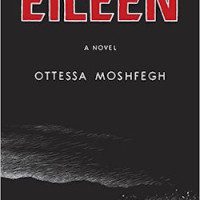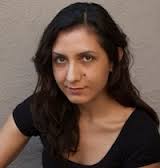Toward the end of Eileen, the titular narrator purloins a golden cloth swathing what is supposed to be the infant Christ in an outdoor nativity scene. But when she lifts the fabric, she reveals that it was concealing an empty canister of motor oil. She takes the cloth and wraps it around a bottle of wine she is to give as a gift at a Christmas Eve party. The moment passes by in the novel quickly and with little explanation, but it’s a telling gesture in a story so concerned not exactly with sacrilege of God, but of oneself, told by a narrator for whom “having to breathe was an embarrassment in itself.”
Ottessa Moshfegh’s short fiction reads like Flannery O’Connor for a new, more disillusioned generation. Her stories are cast with the misfits of society, their behavior often unjust and unexplained. Like O’Connor, she specializes in grotesqueries, her characters garnering little sympathy and are, at times, repulsive. Yet, Moshfegh’s short stories do not usually offer what O’Connor called “a moment of grace,” that fictive window that hinges on personal epiphany. Moshfegh forsakes what is often an unspoken contract in fiction between writer and reader, a fleeting promise of the revelatory, and refuses her readers an easy reward, instead trading notes of resolve for disquieting ellipses.
Eileen, her debut novel from Penguin Press, is in many ways a splash of cold water after the drunken fever dream of McGlue, her first novella that proved her an emerging literary voice to watch. Taking place in 1964, Eileen is set in the cruel winter landscape of a small Massachusetts town simply referred to as X-Ville. The novel gives us a first-person account of a young woman who guards a boys’ penitentiary, while simultaneously caring for her father, an alcoholic ex-cop who disparages her at every opportunity and claims to see ghosts and hoodlums throughout their decrepit house. Obsessed with bodily functions and death, Eileen spends her time dwelling on the macabre and planning an escape to New York City. The narrator is an elderly version of the protagonist, and by unspooling a single week leading up to Christmas, we are left to retrace the dark maze of Eileen’s mind and the events leading up to her “disappearance.” The book enters nearly Dickensian proportions when a glamorous woman named Rebecca is hired at the prison, and Eileen finds a confidant and only friend as the plot crescendos, if languidly, to a harrowing finale.
The cover of Eileen reminds me of that E.L. Doctorow quote that is frequently overused in creative writing workshops across America: “Writing is like driving at night in the fog. You can only see as far as your headlights, but you can make the whole trip that way.” But Moshfegh’s authorial car seems to have busted headlights, on occasion pulling over to the shoulder or straying down hidden avenues, threatening to veer into oncoming traffic; the reader, of course, is a hostage in the backseat during this road trip through the gothic interiors of Eileen’s memory. Moshfegh writes as if to make us wish that she would swerve into the other lane, let us experience the psychological wreckage of an outcast. But she never does.
Eileen herself is much like the prose, lean and rancid. She is immediately unlikable and almost unbearable, with enough self-loathing to make Céline turn away in disgust. Well, good. Until recently there seemed to be a dearth of unlikable female protagonists, or at least an absence of an audience willing to accept them. Too often do fictional characters’ likability factor serve as the measurement of that writing’s quality. But countless authors have created captivating portraits of detestable characters, and unlike the Nabokovian tradition, Moshfegh doesn’t try to disguise her protagonist with any facade of likability. When Claire Messud was asked recently whether she would befriend her protagonist, she answered: “The relevant question isn’t ‘is this a potential friend for me’ but ‘is this character alive?’” That’s hard to answer for Eileen. Her proximity to death—her mother has died, she deals with adolescent murderers daily, she even dons what she calls a “death mask” when she is in public—has almost rendered herself dead, a living ghost whose sole desire is to disappear. At their best, Moshfegh’s sentences are able to probe topics of death with a certain liveliness, as when Eileen describes her fascination with books and darkness:
“I remember selecting one of the thickest books from the public library, a chronicle of ancient Egyptian medicine, to study the gruesome practice of pulling the brains of the dead out through the nose like skeins of yarn. I liked to think of my brain like that, tangled up in my skull. The idea that my brains could be untangled, straightened out, and thus refashioned into a state of peace and sanity was a comforting fantasy.”
She also fantasizes constantly about the icicles that hang over her front door:
I stood imagining them cracking and darting through my breasts, splicing through the thick gristle of my shoulder like bullets or cleaving my brain into pieces.
For a book so concerned with fantasies—of escapism, of her own disappearance, the complicated fantasy of her father’s death (“I felt like killing my father, but I didn’t want him to die”), the romantic fantasy of a coworker, of befriending Rebecca—Eileen is a relatively sober portrait, occasionally leavened by a perverse humor in the vein of Southern Gothic authors. Her sentences are best when they are taut and surgical, slowly exposing the beating heart of the human condition as it begins to rot with loneliness. Moshfegh isn’t immune to the occasional cliché phrase—her and Rebecca were “two peas in a pod,” and at one point she declares she is off to “meet her destiny.” It’s hard to tell whether these are genuine or winks on behalf of Eileen’s naivety, but they can be easily forgiven when faced with the sheer art of pity Moshfegh has nearly perfected. In fact, the most challenging aspect of the novel lies in whether we should sympathize with Eileen or be revulsed by her habits and mindset. At its most effective, the black magic of Moshfegh’s squalid fairy tale allows us to do both.
On the surface, the plot, which could have been tensioned by the mystery of her “disappearance,” is slackened by Eileen’s self-loathing—which vacillates between casual and almost humorously theatrical—and offhand comments about her current life that assure she got out of X-Ville without much immediate trouble. And so, although the book has all the ingredients of a slow-burning noir, it’s really a meditation on the nausea of life. Moshfegh deeply mines the ore of her narrator’s psyche, and although there are plenty of dead canaries, there is little guiding light to aid our escape through what Eileen calls “loud, rabid inner circuitry of my mind.” In the end, it’s the empathy drawn from her penance that demands us to turn each page.
Unlike the endings to her short stories, which are wont to wed bathos with poignancy, Eileen ends on a note of forced revelation in a scene that involves a winter landscape and a motionless deer that is literally caught in the headlights. Although there is a scene evocative of O’Connor’s moment of grace in “A Good Man is Hard to Find,” this final tableau feels more in proximity to the visceral effect Connor channeled. The last scene is a circumstance that could have been transfixing, a moving dilation on the marvel of life itself amid the spoilage of Eileen’s wretched youth, but it feels unearned and almost betraying, a hint that the entire novel could have worked better in a different medium—a short story or a novella. Oh yes, there is a “twist” in the story as well (what sort of noir would be complete without one?). Yet, the twist at the end of the book that happens with Eileen is so haunting because it feels not like a twist of the knife, but an inevitable twist of fate in a life doomed from the start.





